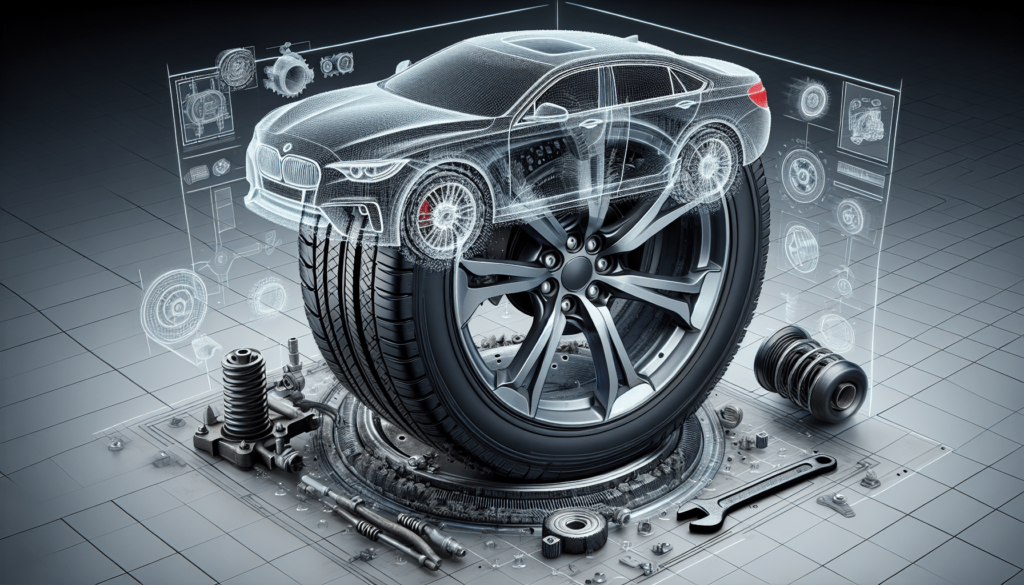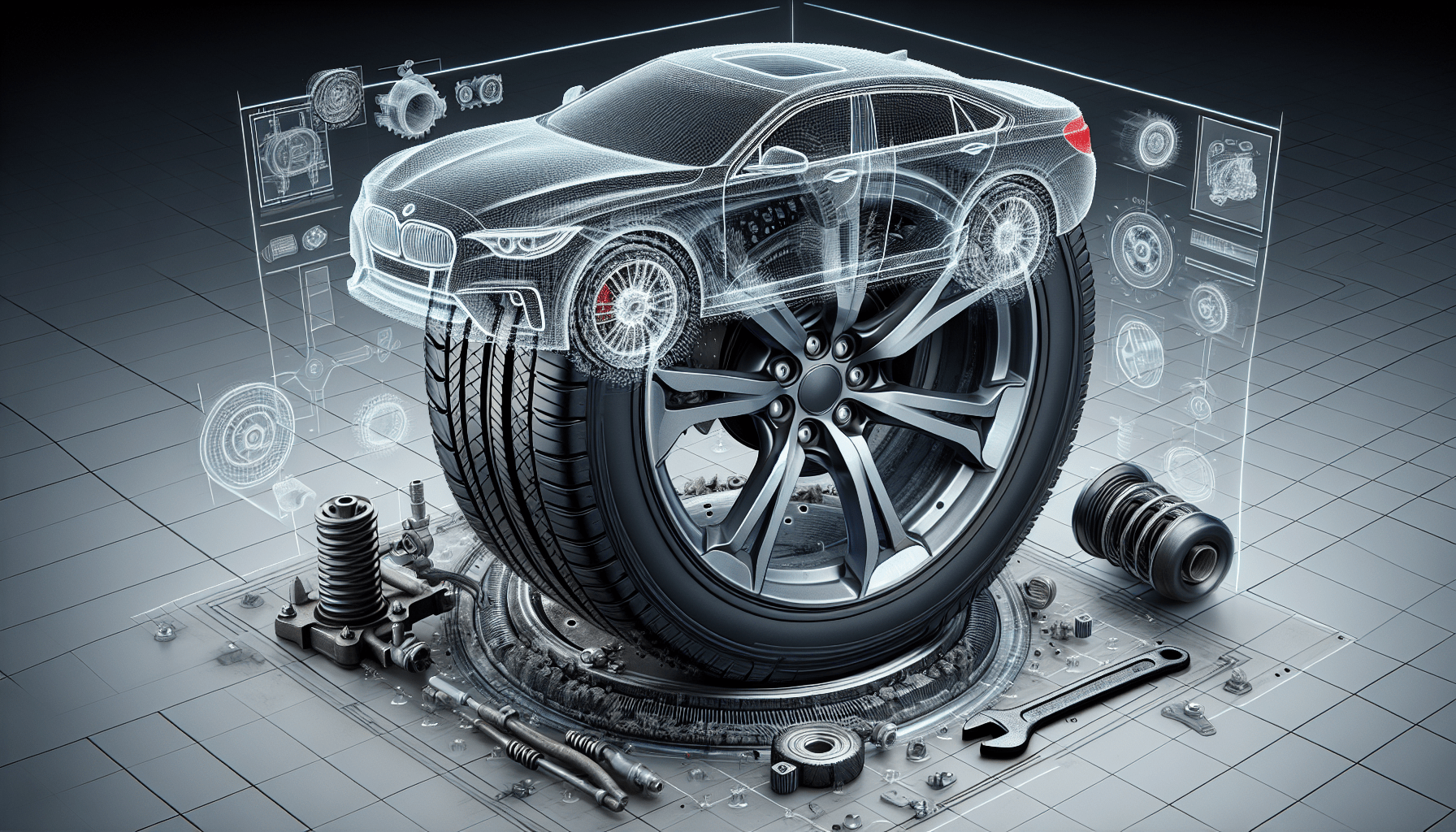Did you know that incorrect wheel alignment can potentially lead to suspension damage? It’s true! When your wheels are not properly aligned, it places added stress on your suspension system, causing it to wear out faster and potentially leading to costly repairs. In this article, we will explore the relationship between wheel alignment and suspension damage, and discuss why maintaining proper alignment is crucial for your vehicle’s overall health and longevity. So, if you’ve ever wondered about the potential consequences of neglecting wheel alignment, read on to find out more!

What is wheel alignment?
Definition
Wheel alignment refers to the adjustment of the angles of the tires so that they are parallel to each other and perpendicular to the ground. It involves adjusting the camber, toe, and caster angles to ensure proper tire contact with the road surface. This alignment is crucial for the overall performance, safety, and longevity of your vehicle.
Importance of wheel alignment
Proper wheel alignment is essential for several reasons. Firstly, it ensures that the tires wear evenly, extending their lifespan and saving you money in the long run. Secondly, it enhances the handling and stability of your vehicle, improving your overall driving experience. Additionally, wheel alignment plays a vital role in fuel efficiency, as misaligned wheels can cause increased rolling resistance and, consequently, higher fuel consumption. Lastly, correct alignment promotes the optimal performance of your suspension system, preventing potential damage and costly repairs.
Symptoms of incorrect wheel alignment
Uneven tire wear
One of the most obvious signs of incorrect wheel alignment is uneven tire wear. When the wheels are misaligned, certain areas of the tires will experience excessive wear, while others remain relatively untouched. This can lead to premature tire deterioration and the need for frequent replacements.
Vehicle pulling to one side
If your vehicle tends to pull to one side while driving on a straight road, it is likely an indication of misaligned wheels. This can occur as a result of unequal toe angles, causing uneven pressure on the tires. Constantly adjusting the steering to keep the vehicle on a straight path can be tiring and dangerous.
Steering wheel vibration
Misaligned wheels can cause the steering wheel to vibrate or shake, particularly at higher speeds. This vibration can be felt through the steering column and is a clear sign that your alignment needs attention. Ignoring this symptom can lead to discomfort and potential further damage to other components of your vehicle.
Off-center steering wheel
A properly aligned vehicle should have a steering wheel centered in its normal driving position. If your steering wheel appears to be off-center, even when driving straight, it could be an indication of wheel misalignment. It is important to address this issue promptly to prevent any further complications.
Uneven brake wear
Incorrect wheel alignment can also cause uneven brake wear. When the wheels are not correctly aligned, it can put uneven pressure on the brake pads, resulting in inconsistent wear patterns. This can affect the overall braking performance of your vehicle and potentially compromise your safety on the road.
Effects of incorrect wheel alignment
Increased tire wear
One of the most significant consequences of incorrect wheel alignment is increased tire wear. When the wheels are misaligned, certain areas of the tires bear more weight and friction than others. This uneven distribution of force causes excessive wear on specific parts of the tire, leading to premature deterioration and the need for replacement sooner than expected.
Decreased fuel efficiency
Misaligned wheels can also have a negative impact on fuel efficiency. When the wheels are not properly aligned, the tires experience increased rolling resistance. This means that the engine has to work harder to move the vehicle, resulting in higher fuel consumption. By ensuring proper wheel alignment, you can optimize fuel efficiency and save on fuel costs.
Poor handling and stability
Correct wheel alignment is essential for optimal handling and stability of your vehicle. When the wheels are misaligned, it can affect the vehicle’s steering response and stability, making it more challenging to control. This can be particularly dangerous in emergency situations or adverse weather conditions. By maintaining proper alignment, you can ensure a smooth and safe driving experience.
Suspension issues
Incorrect wheel alignment can have a detrimental effect on your vehicle’s suspension system. The suspension relies on precise wheel alignment to distribute the weight of the vehicle evenly. When the wheels are misaligned, it can put excessive stress on suspension components, leading to premature wear and potential damage. By addressing alignment issues promptly, you can minimize the risk of suspension problems and costly repairs.
Understanding suspension damage
Components of a vehicle suspension system
To understand how incorrect wheel alignment can lead to suspension damage, it is important to familiarize yourself with the key components of a vehicle’s suspension system. These components include the springs, shock absorbers, control arms, sway bars, steering linkage, and suspension bushings. Each component plays a crucial role in providing a smooth and controlled ride.
Role of wheel alignment in suspension performance
Proper wheel alignment is vital to the performance of the suspension system. When the wheels are aligned correctly, it ensures that the weight of the vehicle is evenly distributed and absorbed by the suspension components. This allows for a more comfortable and stable ride, as well as optimal handling and control. Misaligned wheels can disrupt this balance, placing additional stress on the suspension components and potentially leading to damage over time.

How incorrect wheel alignment can lead to suspension damage
Excessive stress on suspension components
When the wheels are misaligned, the suspension components, such as the springs, shock absorbers, and control arms, can experience excessive stress. The misalignment causes uneven weight distribution, resulting in certain components having to bear more weight than they are designed for. This can lead to premature wear, reduced performance, and potential failure of these critical suspension parts.
Uneven weight distribution
Incorrect wheel alignment can cause uneven weight distribution on the suspension components. This can lead to imbalanced forces acting on the suspension, resulting in increased wear and tear. Over time, this imbalance can cause the suspension to weaken and become less effective in providing a smooth and controlled ride.
Misalignment of control arms
The control arms play a crucial role in maintaining the proper alignment of the wheels and supporting the suspension system. When the wheels are misaligned, it can cause the control arms to become misaligned as well. This misalignment of the control arms can result in excessive stress and strain on the suspension components, leading to potential damage and compromised performance.
Impact on shock absorbers
Misaligned wheels can have a significant impact on the performance of the shock absorbers. The shock absorbers are responsible for dampening the vibrations and impacts from the road surface. When the wheels are misaligned, it can cause the shock absorbers to work unevenly, leading to reduced effectiveness and potential damage to these crucial suspension components.
Strain on steering linkage
The steering linkage connects the steering wheel to the wheels, allowing for proper control and maneuverability of the vehicle. When the wheels are misaligned, it can put additional strain on the steering linkage, affecting its performance and potentially causing premature wear or failure. Proper alignment ensures that the steering linkage operates smoothly and efficiently, preventing unnecessary strain and potential damage.
Common suspension problems caused by incorrect wheel alignment
Premature wear of suspension bushings
Misaligned wheels can contribute to premature wear of the suspension bushings. The suspension bushings help to absorb shocks and vibrations, providing a smoother and more comfortable ride. When the wheels are misaligned, the suspension bushings may have to compensate for the resulting imbalances, leading to accelerated wear and potential failure.
Damage to ball joints
Incorrect wheel alignment can also cause damage to the ball joints. The ball joints connect the control arms to the steering knuckles and allow for smooth movement and articulation. When the wheels are misaligned, it can put excessive stress on the ball joints, leading to wear and potential damage. Failure to address alignment issues promptly can result in costly repairs and compromised safety.
Weakened suspension springs
The suspension springs play a crucial role in supporting the weight of the vehicle and absorbing impacts from the road. When the wheels are misaligned, it can cause uneven weight distribution on the springs, resulting in increased stress and potential weakening over time. This can lead to a loss of suspension effectiveness and a harsher ride quality.
Loosened or broken sway bars
Sway bars, also known as stabilizer bars, help to minimize body roll during turns and provide stability to the vehicle. When the wheels are misaligned, it can put increased strain on the sway bars, potentially leading to loosening or even breakage. This can compromise the handling and stability of the vehicle, making it more challenging to control in various driving conditions.
Misalignment of alignment hardware
Incorrect wheel alignment can also lead to misalignment of the alignment hardware itself. This includes the alignment bolts, nuts, and other components necessary for adjusting the wheel alignment. When the alignment hardware becomes misaligned, it can make it difficult to achieve proper alignment even after adjustments, leading to persistent alignment issues and potential suspension damage.

Signs of suspension damage
Excessive bouncing or dipping
If you notice your vehicle bouncing excessively over bumps or dipping excessively when braking, it may be a sign of suspension damage. These irregular movements can indicate worn or damaged suspension components, resulting from prolonged improper wheel alignment. It is important to have your suspension system inspected promptly to prevent further damage and ensure a safe driving experience.
Increased body roll during turns
When the suspension components are damaged due to incorrect wheel alignment, you may experience increased body roll during turns. Body roll refers to the lateral tilting of the vehicle when cornering. If you notice that your vehicle leans excessively to one side during turns, it could be an indication of weakened suspension components. Addressing the alignment issues promptly can help restore stability and control during cornering maneuvers.
Uneven tire wear patterns
Excessive or uneven tire wear patterns are not only a symptom of incorrect wheel alignment but also indicative of potential suspension damage. Misaligned wheels can cause uneven wear on the tires’ tread, leading to a shorter tire lifespan. If you observe unusual and irregular tire wear patterns, it is crucial to have your alignment and suspension inspected for any underlying issues.
Abnormal noises while driving over bumps
Damaged suspension components can produce abnormal noises when driving over bumps or rough road surfaces. These noises can range from squeaking, knocking, or rattling sounds, and often indicate potential damage or wear. If you notice any unusual noises while driving over bumps, it is advisable to have your suspension system checked to prevent further damage and maintain a smooth and quiet ride.
Difficulty in steering or controlling the vehicle
Suspension damage caused by incorrect wheel alignment can result in difficulty steering or controlling the vehicle. You may notice increased effort required to turn the steering wheel or a sense of looseness in the steering response. These symptoms can severely impact your ability to maneuver the vehicle safely. It is essential to address these issues promptly to avoid compromising your safety on the road.
Preventing suspension damage
Regular wheel alignment checks
To prevent suspension damage, it is crucial to schedule regular wheel alignment checks. It is recommended to have your alignment checked at least once a year or every 10,000 to 12,000 miles, or more frequently if you frequently encounter rough roads or potholes. By staying proactive with your alignment maintenance, you can identify and correct any alignment issues before they lead to suspension damage.
Prompt correction of wheel alignment issues
If you notice any symptoms of incorrect wheel alignment, such as uneven tire wear or pulling to one side, it is important to have the alignment corrected promptly. Delaying alignment adjustments can further exacerbate the issues and increase the risk of suspension damage. By addressing alignment issues promptly, you can minimize the potential for long-term damage and repair costs.
Routine suspension inspections
In addition to regular wheel alignment checks, it is essential to conduct routine suspension inspections. This includes visually inspecting the suspension components for signs of wear, damage, or leaks. Engaging a professional mechanic for a thorough suspension inspection can help identify any underlying issues and allow for timely repairs or replacements if necessary.
Use of quality suspension components
When it comes to maintaining a healthy suspension system, the use of quality suspension components is crucial. Opting for genuine or reputable aftermarket parts can ensure optimal performance, durability, and reliability. Inferior or substandard components may fail prematurely or not provide the necessary support and functionality, leading to increased risk of suspension damage.
Avoiding potholes and rough terrains
To minimize the risk of suspension damage, it is advisable to avoid driving over potholes and rough terrains whenever possible. These road conditions can place significant stress on the suspension components, potentially leading to damage or premature wear. By driving cautiously and avoiding rough roads, you can prolong the lifespan of your suspension system and minimize the likelihood of costly repairs.

Repairing suspension damage caused by incorrect wheel alignment
Assessment by a professional mechanic
If you suspect suspension damage due to incorrect wheel alignment, it is crucial to have your vehicle assessed by a professional mechanic. They will conduct a thorough inspection of the suspension system to identify any damage or worn components. A trained mechanic can accurately diagnose the issues and recommend the necessary repairs or replacements to restore the suspension’s optimal performance.
Replacing damaged suspension components
In cases where suspension components have suffered significant damage due to incorrect wheel alignment, replacement may be necessary. This can include replacing worn-out bushings, ball joints, springs, shock absorbers, or other damaged parts. It is crucial to use quality replacement components to ensure the longevity and functionality of the repaired suspension system.
Realignment of wheel and suspension
After addressing any necessary repairs or component replacements, a professional mechanic will realign the wheels and suspension system. This involves adjusting the camber, toe, and caster angles to the manufacturer’s specifications. By ensuring proper alignment, further damage to the suspension system can be prevented, optimizing the vehicle’s performance and safety.
Proper alignment adjustment techniques
Achieving the correct wheel alignment requires expert knowledge and the use of proper alignment adjustment techniques. This includes utilizing specialized alignment equipment and following detailed procedures to accurately adjust the angles of the wheels. Professional mechanics have the expertise and tools necessary to achieve precise alignment, minimizing any potential for future suspension damage.
Test driving and final inspection
After the realignment process, it is vital to conduct a test drive to assess the vehicle’s handling and suspension performance. This allows the mechanic to ensure that the repairs and adjustments have been successful and that the suspension system is functioning correctly. A final inspection is then performed to ensure that all suspension components are secure, properly aligned, and operating as intended.
Conclusion
Proper wheel alignment is vital for the overall performance, safety, and longevity of your vehicle. Incorrect wheel alignment can lead to various suspension problems and potential damage, impacting tire wear, fuel efficiency, handling, and stability. By understanding the importance of wheel alignment and its role in suspension performance, you can recognize the symptoms of misalignment and take appropriate measures to prevent suspension damage. Regular alignment checks, prompt addressing of alignment issues, routine suspension inspections, and the use of quality components are essential for protecting your suspension system. In cases where suspension damage has occurred, it is crucial to have a professional mechanic assess and repair the damage, including realigning the wheels and conducting a thorough inspection. By staying proactive and maintaining proper wheel alignment, you can enjoy a smooth, safe, and reliable driving experience while minimizing the risk of suspension damage.


